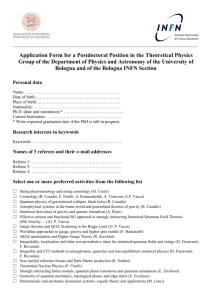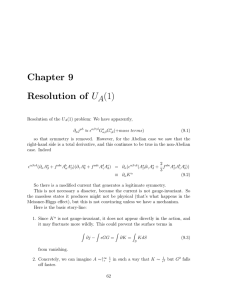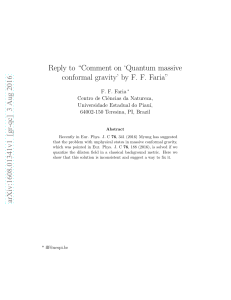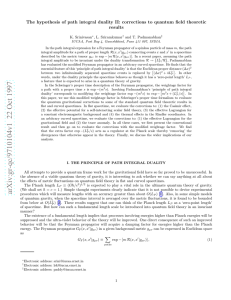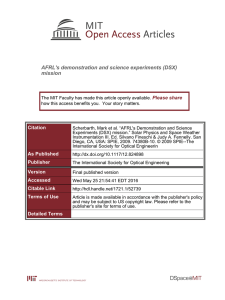Document 10773306
advertisement
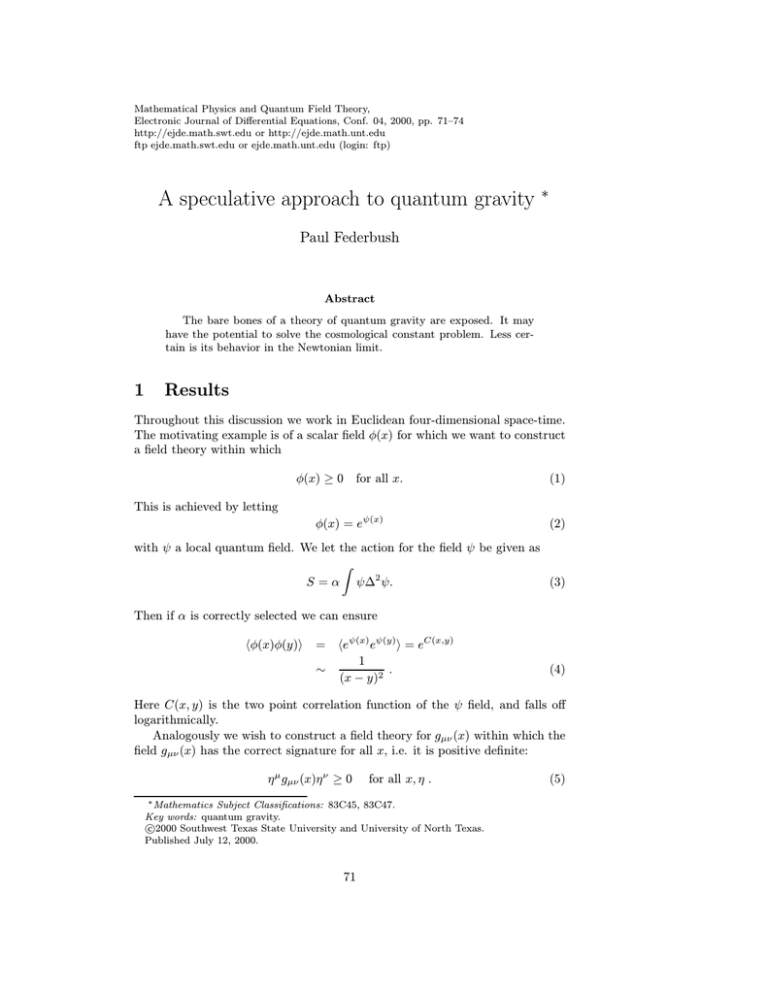
Mathematical Physics and Quantum Field Theory, Electronic Journal of Differential Equations, Conf. 04, 2000, pp. 71–74 http://ejde.math.swt.edu or http://ejde.math.unt.edu ftp ejde.math.swt.edu or ejde.math.unt.edu (login: ftp) A speculative approach to quantum gravity ∗ Paul Federbush Abstract The bare bones of a theory of quantum gravity are exposed. It may have the potential to solve the cosmological constant problem. Less certain is its behavior in the Newtonian limit. 1 Results Throughout this discussion we work in Euclidean four-dimensional space-time. The motivating example is of a scalar field φ(x) for which we want to construct a field theory within which φ(x) ≥ 0 for all x. (1) This is achieved by letting φ(x) = eψ(x) (2) with ψ a local quantum field. We let the action for the field ψ be given as Z S = α ψ∆2 ψ. (3) Then if α is correctly selected we can ensure hφ(x)φ(y)i = heψ(x) eψ(y) i = eC(x,y) 1 ∼ . (x − y)2 (4) Here C(x, y) is the two point correlation function of the ψ field, and falls off logarithmically. Analogously we wish to construct a field theory for gµν (x) within which the field gµν (x) has the correct signature for all x, i.e. it is positive definite: η µ gµν (x)η ν ≥ 0 for all x, η . ∗ Mathematics Subject Classifications: 83C45, 83C47. Key words: quantum gravity. c 2000 Southwest Texas State University and University of North Texas. Published July 12, 2000. 71 (5) 72 A speculative approach to quantum gravity This we achieve by writing gµν (x) = eA(x) µν (6) with A a real symmetric matrix. (Equations (5) and (6) parallel (1) and (2).) We are led to expect that if the action of Aµν is quadratic with four derivatives, the two point function of gµν may have a desired form. With an action given as Z √ (7) g αRµν Rµν + βR2 Sg = the quadratic part of Sg , in terms of the Aµν fields, is of this form, containing only four derivative terms. The gauge fixing terms may also be chosen consistent with this requirement [6]. We then may hope that for a suitable choice of α and β the two point function (as computed using only the quadratic terms of the action) may be of appropriate form. It would be ideal if the values of α and β of the full theory arose as an infrared fixed point of the renormalization group. We make a number of comments and observations: (1) The theory is power-counting renormalizable. It is possible that a complete theory of renormalizability may beginequation carried out as in [6]. (2) The theory formally solves the cosmological constant problem, since it is invariant under gµν → Cgµν . We believe this formal invariance can be extended through the quantization procedure. (3) The theory is a large coupling theory. This is because α and β chosen to pattern the two point function, will not beginequation small. The expression we get for the two point function, as we have discussed it, will beginequation non-perturbative in a large coupling theory. This will make calculations difficult and not necessarily reliable. Perhaps we are dealing with the “correct” theory, but in not the best formalism. (4) Unitarity is as elusive as usual in higher derivative theories. It is perhaps present in low orders. We do not know how important unitarity is to a theory of gravitation. (5) The heart of our present considerations is the Gaussian approximation to the two point function: E Z R −1 1 A(x) A(y) ∼ dA e− 2 AC A eA(x) eA(y) he e (8) written in a slightly schematic notation. The integrals are very non-trivial because of the matrix nature of exponentials: . (9) eA(x) ij Paul Federbush 73 The evaluation of (8) is made possible (though still complicated) using the Fourier transformation of the exponential in eq. (9) in terms of the entries of A: Z h 1 8 68 52 A Tr(AW )W e = dΩeTr(AW ) I + (W − I) − Tr(AW )I + 3 4 3 3 1 − 4 Tr(A2 ) + 46(Tr(AW ))2 + 2A Tr(AW ) W −A + (10) 6 1 1 − − Tr(A2 )I + 3(Tr(AW ))2 I + A2 + 2A Tr(AW ) 6 2 i 1 1 2 Tr(A3 )W − Tr(A2 ) Tr(AW )W . + (Tr(AW ))3 W − 3 18 6 This expression R is from [1], and is written here for a traceless 4 × 4 matrix. The integral dΩ is the integral over the unit sphere in C4 , of a vector vi with respect to the normalized unitary-invariant measure. And W is the hermitian rank one projection given as Wij = vi v̄j . (11) The program we envision is to select α and β so that the Gaussian approximation, eq. (8), yields a “nearly reasonable” two point function; and to seek the ultimate two point function, via perturbative corrections. The correct two point functions would yield most of the tested properties of general relativity. Remembering that we are working with a large coupling theory, we expect it to beginequation difficult to get accurate predictions, to prove or disprove the theory. This is a property we share with string theory. (6) We do not know what gauge condition will prove best to study the present theory. We have considered the condition X ∂µ Aµν = 0 (12) µ as being one possibility. For this gauge condition we have found a generalized BRS invariance [2], (more general than the generalized BRS transformations studied in [5]). Of course for the usual harmonic gauge condition, the same BRS transformation as used in [6] is expected to apply to the current model. (7) There has been some research on the cosmological implications of actions as in eq. (7), [3]. For us the pressure is to find consistency with the Newtonian limit and the tests of general relativity. (8) As a final subjective point we find many aspects of the present theory (so far studied only fragmentally) to be aesthetic. 74 A speculative approach to quantum gravity References [1] P. Federbush, “e to the A, in a New Way”, math-ph/9903006, to be published in the Michigan Math. Journal. P. Federbush, “e to the A, in a New Way, Some More to Say”, mathph/0004023. [2] P. Federbush, “Some Generalized BRS Transformations”, hep-th/9906245, hep-th/9907138. [3] P. D. Mannheim, “Conformal Gravity and a Naturally Small Cosmological Constant”, astro-ph/9901219. [4] P. D. Mannhein, “Curvature and Cosmic Repulsion”, astro-ph/9803135. [5] Satish, D. Joglekar, A. Misra, “Relating Green’s Functions in Axial and Lorentz Gauges Using Finite Field-Dependent BRS Transformations”, hepth/9812101. [6] K. S. Stelle, “Renormalization of higher-derivative quantum gravity”, Phys. Rev. D, 16 953-969 (1977) Paul Federbush Department of Mathematics, University of Michigan Ann Arbor, MI 48109-1109, USA e-mail: pfed@math.lsa.umich.edu
